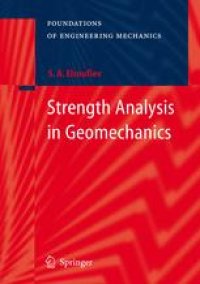
Ebook: Strength Analysis in Geomechanics
Author: Serguey A. Elsoufiev (auth.)
- Tags: Structural Mechanics, Geotechnical Engineering, Computational Intelligence, Continuum Mechanics and Mechanics of Materials
- Series: Foundations Engineering Mechanics
- Year: 2007
- Publisher: Springer Berlin Heidelberg
- Language: English
- pdf
The book presents a new approach for the solution of geomechanical problems - it explicitly takes into account deformation and fracture in time, which are neglected in classical methods although these properties create important effects. The method reveals the influence of the form of a structure on its ultimate state. It uses the rheological law which accounts for large strains at a non-linear unsteady creep, an influence of a stress state type, an initial anisotropy and damage. The whole approach takes into account five types of non-linearity (physical as well as geometrical ones) and contains several new ideas. For example, it considers the fracture as a process, the difference between the body and an element of the material which only deforms and fails because it is in the structure, the simplicity of some non-linear computations against the consequent linear ones, the dependence of the maximum strain in dangerous poins of the body only on the material.
The book presents a new approach for the solution of geomechanical problems - it explicitly takes into account deformation and fracture in time, which are neglected in classical methods although these properties create important effects. The method reveals the influence of the form of a structure on its ultimate state. It uses the rheological law which accounts for large strains at a non-linear unsteady creep, an influence of a stress state type, an initial anisotropy and damage. The whole approach takes into account five types of non-linearity (physical as well as geometrical ones) and contains several new ideas. For example, it considers the fracture as a process, the difference between the body and an element of the material which only deforms and fails because it is in the structure, the simplicity of some non-linear computations against the consequent linear ones, the dependence of the maximum strain in dangerous poins of the body only on the material.
Content:
Front Matter....Pages I-XIV
Introduction: Main Ideas....Pages 1-29
Main Equations in Media Mechanics....Pages 31-45
Some Elastic Solutions....Pages 47-83
Elastic-Plastic and Ultimate State of Perfect Plastic Bodies....Pages 85-124
Ultimate State of Structures at Small Non-Linear Strains....Pages 125-160
Ultimate State of Structures at Finite Strains....Pages 161-183
Back Matter....Pages 185-233
The book presents a new approach for the solution of geomechanical problems - it explicitly takes into account deformation and fracture in time, which are neglected in classical methods although these properties create important effects. The method reveals the influence of the form of a structure on its ultimate state. It uses the rheological law which accounts for large strains at a non-linear unsteady creep, an influence of a stress state type, an initial anisotropy and damage. The whole approach takes into account five types of non-linearity (physical as well as geometrical ones) and contains several new ideas. For example, it considers the fracture as a process, the difference between the body and an element of the material which only deforms and fails because it is in the structure, the simplicity of some non-linear computations against the consequent linear ones, the dependence of the maximum strain in dangerous poins of the body only on the material.
Content:
Front Matter....Pages I-XIV
Introduction: Main Ideas....Pages 1-29
Main Equations in Media Mechanics....Pages 31-45
Some Elastic Solutions....Pages 47-83
Elastic-Plastic and Ultimate State of Perfect Plastic Bodies....Pages 85-124
Ultimate State of Structures at Small Non-Linear Strains....Pages 125-160
Ultimate State of Structures at Finite Strains....Pages 161-183
Back Matter....Pages 185-233
....